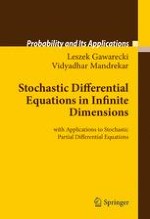The systematic study of existence, uniqueness, and properties of solutions to stochastic differential equations in infinite dimensions arising from practical problems characterizes this volume that is intended for graduate students and for pure and applied mathematicians, physicists, engineers, professionals working with mathematical models of finance. Major methods include compactness, coercivity, monotonicity, in a variety of set-ups. The authors emphasize the fundamental work of Gikhman and Skorokhod on the existence and uniqueness of solutions to stochastic differential equations and present its extension to infinite dimension. They also generalize the work of Khasminskii on stability and stationary distributions of solutions. New results, applications, and examples of stochastic partial differential equations are included. This clear and detailed presentation gives the basics of the infinite dimensional version of the classic books of Gikhman and Skorokhod and of Khasminskii in one concise volume that covers the main topics in infinite dimensional stochastic PDE’s. By appropriate selection of material, the volume can be adapted for a 1- or 2-semester course, and can prepare the reader for research in this rapidly expanding area.





